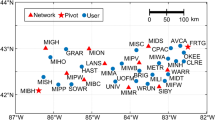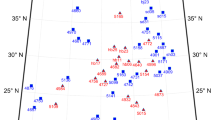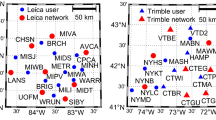Abstract
Network real-time kinematic (NRTK) positioning is today’s industry standard for high-precision applications. Once network ambiguities are fixed, the network engine processes simultaneous observations from a number of continuously operating reference stations to compute corrections for users operating within the network area. Users are treated as passive nodes of the network. However, if two-way communication is available, then users could transmit their observations to the central processing facility where the network can treat them as active nodes, densifying the existing network infrastructure. This multiple rover network (MRN) concept exploits the additional information provided by users in a GNSS network. One application is to use the shorter inter-receiver distances to improve the success rate of single-epoch ambiguity resolution. This is also the goal of the subset ambiguity resolution algorithm, which improves the single-epoch success rate by allowing a subset of ambiguities to be resolved. We present an enhanced processing strategy to complement centimeter-level single-epoch NRTK positioning. This approach combines a single-baseline and an MRN solution with the partial ambiguity resolution algorithm and is only possible for a centralized GNSS network architecture. The algorithm is tested against the standard network ambiguity resolution strategy of full-set ambiguity fixing with respect to the nearest reference station. A 24-h dataset from the Southern California Integrated GNSS network is used with a configuration of three reference stations and four users. The enhanced solution achieves a mean ambiguity resolution success rate of 83% over all four users and all epochs, compared to 32% for the conventional technique.









Similar content being viewed by others
References
European Space Agency (2004) Galileo: Galileo reference troposphere model for the user receiver. ESA-APPNG-REF/00621-AM
Parkins A (2011) Increasing GNSS RTK availability with a new single-epoch batch partial ambiguity resolution algorithm. J GPS Solut 15(4):391–402
Rizos C (2007) Alternatives to current GPS-RTK services and some implications for CORS infrastructure and operations. GPS Solut 11(3):151–158
Rothacher M, Schmid R (2006) ANTEX: the antenna exchange format V. 1.3
Schaer S, Gurtner W (1998) IONEX: the IONosphere Map Exchange Format Version 1. Astronomical Institute, University of Berne, Switzerland, ESA/ESOC, Darmstadt, Germany, 25 Feb 1998
Teunissen PJG (1994) A new method for fast carrier phase ambiguity estimation. In: Proceedings of IEEE PLANS’94, Las Vegas, NV, 11–15 Apr, pp 562–573
Verhagen AA (2004) The GNSS integer ambiguities: estimation and validation. PhD Thesis, University of Delft
Vollath U, Buecherl A, Landau H (2000) Long range RTK positioning using virtual reference stations. In: Proceedings of Institute of Navigation National GPS 2000 Salt Lake City, Utah, 19–22 Sept, pp 1143–1147
Wubenna G, Bagge A, Seeber G, Volker B, Hankemeier P (1996) Reducing distance dependent errors for real time precise DGPS applications by establishing reference station networks. In: Proceedings of Institute of Navigation National GPS 1996 Kansas, vol 2, 17–20 Sept, pp 1845–1852
Zinas N (2009) Assessment of a new rover- enhanced network-based real time kinematic GNSS data processing strategy. In: Proceedings of the ION GNSS 2009, Savannah-Georgia, USA, 22–15 Sept, pp 2717–2726
Author information
Authors and Affiliations
Corresponding author
Rights and permissions
About this article
Cite this article
Zinas, N., Parkins, A. & Ziebart, M. Improved network-based single-epoch ambiguity resolution using centralized GNSS network processing. GPS Solut 17, 17–27 (2013). https://doi.org/10.1007/s10291-012-0256-x
Received:
Accepted:
Published:
Issue Date:
DOI: https://doi.org/10.1007/s10291-012-0256-x




